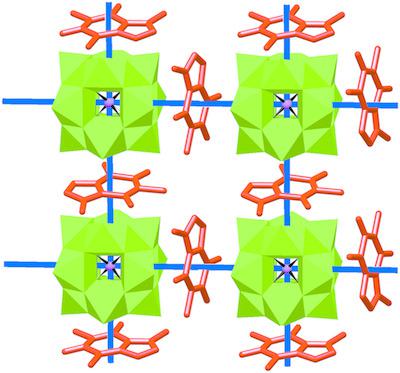当前位置:
X-MOL 学术
›
Acta Cryst. C
›
论文详情
Our official English website, www.x-mol.net, welcomes your
feedback! (Note: you will need to create a separate account there.)
Supramolecular networks supported by the anion...π linkage of Keggin-type heteropolyoxotungstates.
Acta Crystallographica Section C ( IF 0.7 ) Pub Date : 2020-07-21 , DOI: 10.1107/s205322962000950x Olha S Panteleieva 1 , Vira V Ponomarova 2 , Alexander V Shtemenko 1 , Kostiantyn V Domasevitch 2
Acta Crystallographica Section C ( IF 0.7 ) Pub Date : 2020-07-21 , DOI: 10.1107/s205322962000950x Olha S Panteleieva 1 , Vira V Ponomarova 2 , Alexander V Shtemenko 1 , Kostiantyn V Domasevitch 2
Affiliation

|
Anion…π interactions are newly recognized weak supramolecular forces which are relevant to many types of electron‐deficient aromatic substrates. Being less competitive with respect to conventional hydrogen bonding, anion…π interactions are only rarely considered as a crystal‐structure‐defining factor. Their significance dramatically increases for polyoxometalate (POM) species, which offer extended oxide surfaces for maintaining dense aromatic/inorganic stacks. The structures of tetrakis(caffeinium) μ12‐silicato‐tetracosa‐μ2‐oxido‐dodecaoxidododecatungsten trihydrate, (C8H11N4O2)4[SiW12O40]·3H2O, (1), and tris(theobrominium) μ12‐phosphato‐tetracosa‐μ2‐oxido‐dodecaoxidododecatungsten ethanol sesquisolvate, (C7H9N4O2)3[PW12O40]·1.5C2H5OH, (2), support the utility of anion…π interactions as a special kind of supramolecular synthon controlling the structures of ionic lattices. Both caffeinium [(HCaf)+ in (1)] and theobrominium cations [(HTbr)+ in (2)] reveal double stacking patterns at both axial sides of the aromatic frameworks, leading to the generation of anion…π…anion bridges. The latter provide the rare face‐to‐face linkage of the anions. In (1), every square face of the metal–oxide cuboctahedra accepts the interaction and the above bridges yield flat square nets, i.e. {(HCaf+)2[SiW12O40]4−}n. Two additional cations afford single stacks only and they terminate the connectivity. Salt (2) retains a two‐dimensional (2D) motif of square nets, with anion…π…anion bridges involving two of the three (HTbr)+ cations. The remaining cations complete a fivefold anion…π environment of [PW12O40]3−, acting as terminal groups. This single anion…π interaction is influenced by the specific pairing of (HTbr)+ cations by double amide‐to‐amide hydrogen bonding. Nevertheless, invariable 2D patterns in (1) and (2) suggest the dominant role of anion…π interactions as the structure‐governing factor, which is applicable to the construction of noncovalent linkages involving Keggin‐type oxometalates.
中文翻译:

超分子网络由Keggin型杂多氧钨酸盐的阴离子...π键支撑。
阴离子…π相互作用是新发现的弱超分子力,与许多类型的电子不足的芳香族底物有关。与常规氢键相比,竞争性较弱,阴离子…π相互作用极少被视为确定晶体结构的因素。对于多金属氧酸盐(POM)种类,它们的重要性显着增加,而多金属氧酸盐提供了扩展的氧化物表面以保持致密的芳族/无机堆叠。四的结构(caffeinium)μ 12 -silicato-二十四烷μ 2 -oxido-dodecaoxidododecatungsten三水合物,(C 8 H ^ 11 Ñ 4 Ò 2)4【硅钨酸12 ø 40 ]·3H 2O,(1),和三(theobrominium)μ 12 -phosphato-二十四烷μ 2 -oxido-dodecaoxidododecatungsten乙醇sesquisolvate,(C 7 H ^ 9 Ñ 4 Ò 2)3 [PW 12 ø 40 ]·1.5C 2 H ^ 5 OH(2)支持阴离子…π相互作用作为控制离子晶格结构的一种特殊的超分子合成子。咖啡因[[(1)中的(HCaf)+ ]和可可碱阳离子[(HTbr)+((2)中的[2])揭示了在芳族骨架的轴向两侧的双重堆积模式,从而导致了阴离子…π…阴离子桥的产生。后者提供了罕见的阴离子面对面连接。在(1)中,金属氧化物立方八面体的每个方形表面都接受相互作用,并且上述桥产生平坦的方形网,即{(HCaf +)2 [SiW 12 O 40 ] 4− } n。另外两个阳离子仅提供单个堆栈,它们终止了连接。盐(2)保留了方网的二维(2D)图案,其中阴离子…π…阴离子桥涉及三个(HTbr)+中的两个阳离子。其余阳离子完成[PW 12 O 40 ] 3-的五重阴离子…π环境,用作末端基团。这种单阴离子…π相互作用受(HTbr)+阳离子通过酰胺-酰胺双氢键的特定配对影响。但是,(1)和(2)中的不变2D模式表明阴离子…π相互作用作为结构控制因子的主导作用,适用于涉及Keggin型含金属氧酸盐的非共价键的构建。
更新日期:2020-07-21
中文翻译:

超分子网络由Keggin型杂多氧钨酸盐的阴离子...π键支撑。
阴离子…π相互作用是新发现的弱超分子力,与许多类型的电子不足的芳香族底物有关。与常规氢键相比,竞争性较弱,阴离子…π相互作用极少被视为确定晶体结构的因素。对于多金属氧酸盐(POM)种类,它们的重要性显着增加,而多金属氧酸盐提供了扩展的氧化物表面以保持致密的芳族/无机堆叠。四的结构(caffeinium)μ 12 -silicato-二十四烷μ 2 -oxido-dodecaoxidododecatungsten三水合物,(C 8 H ^ 11 Ñ 4 Ò 2)4【硅钨酸12 ø 40 ]·3H 2O,(1),和三(theobrominium)μ 12 -phosphato-二十四烷μ 2 -oxido-dodecaoxidododecatungsten乙醇sesquisolvate,(C 7 H ^ 9 Ñ 4 Ò 2)3 [PW 12 ø 40 ]·1.5C 2 H ^ 5 OH(2)支持阴离子…π相互作用作为控制离子晶格结构的一种特殊的超分子合成子。咖啡因[[(1)中的(HCaf)+ ]和可可碱阳离子[(HTbr)+((2)中的[2])揭示了在芳族骨架的轴向两侧的双重堆积模式,从而导致了阴离子…π…阴离子桥的产生。后者提供了罕见的阴离子面对面连接。在(1)中,金属氧化物立方八面体的每个方形表面都接受相互作用,并且上述桥产生平坦的方形网,即{(HCaf +)2 [SiW 12 O 40 ] 4− } n。另外两个阳离子仅提供单个堆栈,它们终止了连接。盐(2)保留了方网的二维(2D)图案,其中阴离子…π…阴离子桥涉及三个(HTbr)+中的两个阳离子。其余阳离子完成[PW 12 O 40 ] 3-的五重阴离子…π环境,用作末端基团。这种单阴离子…π相互作用受(HTbr)+阳离子通过酰胺-酰胺双氢键的特定配对影响。但是,(1)和(2)中的不变2D模式表明阴离子…π相互作用作为结构控制因子的主导作用,适用于涉及Keggin型含金属氧酸盐的非共价键的构建。











































 京公网安备 11010802027423号
京公网安备 11010802027423号